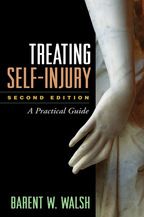Treating Self-Injury
Second Edition
A Practical Guide
Barent W. Walsh
1. Definition and Differentiation from Suicide
2. The Relationship between Self-Injury and Suicide
3. An Overview of Direct and Indirect Self-Harm
4. Major Groups in Which Self-Injury Occurs
5. Body Piercings, Tattoos, Brandings, Scarifications, and Other Forms of Body Modification
6. A Biopsychosocial Model for Self-Injury
II. Assessment and Treatment: A Stepped-Care Model
Treatment: Step 1
7. Initial Therapeutic Responses
8. Formal Assessment of Self-Injury, Jennifer J. Muehlenkamp
9. Cognitive-Behavioral Assessment
10. Contingency Management
Treatment: Step 2
11. Replacement Skills Training
12. Cognitive Treatment
13. Family Therapy, Michael Hollander
14. Psychopharmacological Treatment, Gordon P. Harper
Treatment: Step 3
15. Body Image Work
16. Prolonged Exposure or Cognitive Restructuring for Treating PTSD and Related Self-Injury
Treatment: Step 4
17. Treating Persons with Multiple Self-Harm Behaviors
18. Residential Treatment Targeting Self-Injury and Suicidal Behavior in Adolescents, with Leonard A. Doerfler and Ariana Perry
III. Specialized Topics
19. Managing Reactions to Self-Injury: A Guide for Therapists and Other Caregivers
20. Social Contagion and Self-Injury
21. A Protocol for Managing Self-Injury in School Settings
22. Asphyxial Risk Taking (the Choking Game), Amy M. Brausch
23. Understanding, Managing, and Treating Foreign-Body Ingestion, with Ariana Perry
24. Self-Injury in Correctional Settings, Kenneth L. Appelbaum
25. Treating Major Self-Injury
Afterword
Appendix A: Breathing Manual
Appendix B: Body Attitudes Scale (BAS)
Appendix C: Clinical Scales to Assess Self-Injury
Appendix D: Helpful Websites Related to Self-Injury
Appendix E: Bill of Rights for People Who Self-Harm



